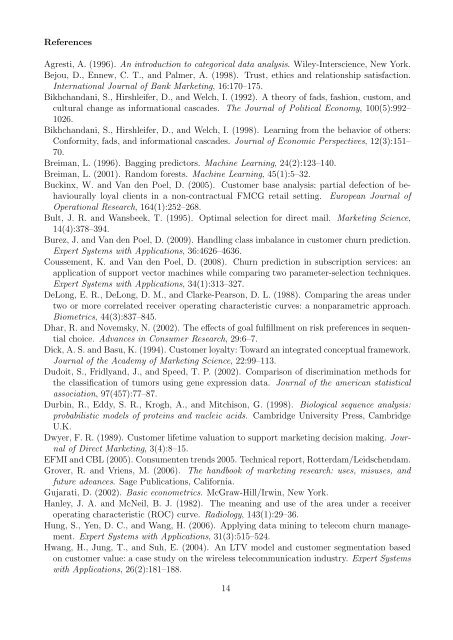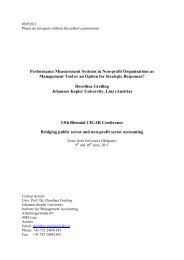Predicting Partial Customer Churn Using Markov for Discrimination ...
Predicting Partial Customer Churn Using Markov for Discrimination ...
Predicting Partial Customer Churn Using Markov for Discrimination ...
You also want an ePaper? Increase the reach of your titles
YUMPU automatically turns print PDFs into web optimized ePapers that Google loves.
References<br />
Agresti, A. (1996). An introduction to categorical data analysis. Wiley-Interscience, New York.<br />
Bejou, D., Ennew, C. T., and Palmer, A. (1998). Trust, ethics and relationship satisfaction.<br />
International Journal of Bank Marketing, 16:170–175.<br />
Bikhchandani, S., Hirshleifer, D., and Welch, I. (1992). A theory of fads, fashion, custom, and<br />
cultural change as in<strong>for</strong>mational cascades. The Journal of Political Economy, 100(5):992–<br />
1026.<br />
Bikhchandani, S., Hirshleifer, D., and Welch, I. (1998). Learning from the behavior of others:<br />
Con<strong>for</strong>mity, fads, and in<strong>for</strong>mational cascades. Journal of Economic Perspectives, 12(3):151–<br />
70.<br />
Breiman, L. (1996). Bagging predictors. Machine Learning, 24(2):123–140.<br />
Breiman, L. (2001). Random <strong>for</strong>ests. Machine Learning, 45(1):5–32.<br />
Buckinx, W. and Van den Poel, D. (2005). <strong>Customer</strong> base analysis: partial defection of behaviourally<br />
loyal clients in a non-contractual FMCG retail setting. European Journal of<br />
Operational Research, 164(1):252–268.<br />
Bult, J. R. and Wansbeek, T. (1995). Optimal selection <strong>for</strong> direct mail. Marketing Science,<br />
14(4):378–394.<br />
Burez, J. and Van den Poel, D. (2009). Handling class imbalance in customer churn prediction.<br />
Expert Systems with Applications, 36:4626–4636.<br />
Coussement, K. and Van den Poel, D. (2008). <strong>Churn</strong> prediction in subscription services: an<br />
application of support vector machines while comparing two parameter-selection techniques.<br />
Expert Systems with Applications, 34(1):313–327.<br />
DeLong, E. R., DeLong, D. M., and Clarke-Pearson, D. L. (1988). Comparing the areas under<br />
two or more correlated receiver operating characteristic curves: a nonparametric approach.<br />
Biometrics, 44(3):837–845.<br />
Dhar, R. and Novemsky, N. (2002). The effects of goal fulfillment on risk preferences in sequential<br />
choice. Advances in Consumer Research, 29:6–7.<br />
Dick, A. S. and Basu, K. (1994). <strong>Customer</strong> loyalty: Toward an integrated conceptual framework.<br />
Journal of the Academy of Marketing Science, 22:99–113.<br />
Dudoit, S., Fridlyand, J., and Speed, T. P. (2002). Comparison of discrimination methods <strong>for</strong><br />
the classification of tumors using gene expression data. Journal of the american statistical<br />
association, 97(457):77–87.<br />
Durbin, R., Eddy, S. R., Krogh, A., and Mitchison, G. (1998). Biological sequence analysis:<br />
probabilistic models of proteins and nucleic acids. Cambridge University Press, Cambridge<br />
U.K.<br />
Dwyer, F. R. (1989). <strong>Customer</strong> lifetime valuation to support marketing decision making. Journal<br />
of Direct Marketing, 3(4):8–15.<br />
EFMI and CBL (2005). Consumenten trends 2005. Technical report, Rotterdam/Leidschendam.<br />
Grover, R. and Vriens, M. (2006). The handbook of marketing research: uses, misuses, and<br />
future advances. Sage Publications, Cali<strong>for</strong>nia.<br />
Gujarati, D. (2002). Basic econometrics. McGraw-Hill/Irwin, New York.<br />
Hanley, J. A. and McNeil, B. J. (1982). The meaning and use of the area under a receiver<br />
operating characteristic (ROC) curve. Radiology, 143(1):29–36.<br />
Hung, S., Yen, D. C., and Wang, H. (2006). Applying data mining to telecom churn management.<br />
Expert Systems with Applications, 31(3):515–524.<br />
Hwang, H., Jung, T., and Suh, E. (2004). An LTV model and customer segmentation based<br />
on customer value: a case study on the wireless telecommunication industry. Expert Systems<br />
with Applications, 26(2):181–188.<br />
14
















